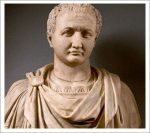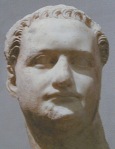The grandest of all ancient Roman structures is the Flavian amphitheater, begun under Emperor Vespasian and finished less than 10 years later under Emperor Titus in 80 AD. While in ruin, it remains a symbol of Rome and a very impressive shell of its former self. It was designated one of the new 7 Wonders of the World in 2007. The Colosseum is an example of advanced Roman engineering and design. When it was in use, it could hold as many as 80,000 people, and functioned in every way that a modern sports stadium does today. It was designed to move people in and out effectively, with 80 arched entrances/exits on all sides, stairs leading directly to sections of seating, and several ringed corridors on multiple levels.
 It was built on the site of Emperor Nero’s man-made lake and golden house for a specific reason- to discredit the tyrant Nero and symbolically return Rome to the people in the form of a building all of Rome would make use of. Nero had also erected a 90 ft. tall golden statue of himself in the spot. Called the Colossus, Vespasian had the face altered to that of the sun-god and kept the statue. Within a few years, Romans were already calling the building “the Colosseum” after the Colossus. Today, the name is used around the world to describe large sports stadiums. The Romans began building by draining a lake (no small feat) and then used stone and concrete. A building like the Colosseum wouldn’t be possible without concrete, which was a Roman invention and a huge step forward in architecture. It allowed them to mold a foundation using wooden molds that would have been nearly impossible with stone. It also would have taken forever. They also built the entire structure using the second great Roman intention, the arch. Arches allowed the even distribution of weight to provide strength while using much less building material and opening up the space for light and air flow. The Colosseum is a ring of 80 arches 3 levels high, or 240 total. These supported a huge upper structure, which had wooden poles and elaborate rigging that allowed massive awnings to be extended out over the arena, shielding spectators from the burning sun.
It was built on the site of Emperor Nero’s man-made lake and golden house for a specific reason- to discredit the tyrant Nero and symbolically return Rome to the people in the form of a building all of Rome would make use of. Nero had also erected a 90 ft. tall golden statue of himself in the spot. Called the Colossus, Vespasian had the face altered to that of the sun-god and kept the statue. Within a few years, Romans were already calling the building “the Colosseum” after the Colossus. Today, the name is used around the world to describe large sports stadiums. The Romans began building by draining a lake (no small feat) and then used stone and concrete. A building like the Colosseum wouldn’t be possible without concrete, which was a Roman invention and a huge step forward in architecture. It allowed them to mold a foundation using wooden molds that would have been nearly impossible with stone. It also would have taken forever. They also built the entire structure using the second great Roman intention, the arch. Arches allowed the even distribution of weight to provide strength while using much less building material and opening up the space for light and air flow. The Colosseum is a ring of 80 arches 3 levels high, or 240 total. These supported a huge upper structure, which had wooden poles and elaborate rigging that allowed massive awnings to be extended out over the arena, shielding spectators from the burning sun.
The main attractions were public executions and gladiator fights, often with wild animals brought to Rome from across the empire. It’s difficult in our modern world to understand the Roman mindset concerning entertainment. They were a bloodthirsty people who viewed killing as sport, and to them the gladiators were a lesser species all together. When the building was finally finished, Emperor Titus ordered 100 straight days of games in celebration, a horrific stretch where 5,000 people and wild animals were killed. The Romans had a knack for theater too, and would often use the arena to set up historical or mythical battle scenarios and allow them to play out. There’s evidence that they created a false landscape with dirt and trees in the center to stage a wild-animal hunt. They aqueduct was also diverted to flood the center of the arena for mock naval battles among gladiators.
Under Domitian, the hypogeum was added. Today, you can see it as a confusing maze of tunnels below ground level in the center of the Colosseum. It originally had a wooden floor built on top and covered with sand. The maze had cages for animals and slaves, and a series of pulleys and elevators could make them appear in the arena along with scenery. The Colosseum remained in various stages of use for a few hundred years until fires, earthquakes and the fall of Rome led to its decay.
During the Middle Ages, the Colosseum was used as a church, a cemetery and a fortress. In 1349 a huge earthquake caused the entire south side outer wall to collapse, which is why the Colosseum looks like an oval today. The original facade is still visible on the north side, without the many statues that used to fill the arches. There are also big holes today along the entire wall, which originally supported big brass fasteners that held great pieces of stone. These were taken and reused long ago. The Colosseum’s main use for a long time was as a quarry for stone and material. There were marble seats inside the entire structure, long since removed and reused in the building of Rome’s churches, including St. Peters. Today, only 1 small portion of the seats exists inside.
The Colosseum is a modern day roundabout for traffic in Rome, with lots of cars constantly buzzing by. Much of the restoration in recent years has been to remove the effects of pollution. Today millions tour the building every year, and more than a few modern-day Romans make a killing dressing up as gladiators for photo-ops. A huge debate rages on in Italy about the cost of restoration, as millions are needed to keep the Colosseum and other ancient ruins from further falling apart.
Here’s a fantastic site that has lots of other Colosseum info, as well as free downloadable travel movies and audio tours you can put on your iPod for when we’re there. It also has some virtual 360° shots of the Colosseum… absolutely the best resource online for this stuff. Pretty cool indeed-









